HTC Sensation 4G Review - A Sensational Smartphone
by Brian Klug on July 1, 2011 12:38 AM EST- Posted in
- Smartphones
- HTC
- Android
- Mobile
- HTC Sensation
- MSM8260
Display
I suppose that’s as good a segue as any into the Sensation’s display. It’s a 4.3” qHD (960x540) “Super LCD” display. As the displays editor in addition to smartphone editor here at AT, I have to admit that I’m granted an interesting perspective. On one hand, you have the traditional desktop LCD market, which is currently mid-stroke in a frenzied race to the bottom, and on the other, the new and emerging world of sub 10” mobile displays. Well, anything tablet sized and below.
I find myself more excited and concerned with mobile displays at any given time than desktop LCDs because that’s where everything exciting is going on. Further, it’s mobile displays where all the new innovation and competition is happening - Super LCD, AMOLED, Super AMOLED with and without Plus, qHD LCD, and qHD LCD with PenTile, all in just the last year! On the desktop side, it seems everyone wants to outdo each other at shaving another $20 off mediocre 1080P TN panels.
In the mobile game right now, you need to have some sort of non garden variety display on a flagship device, and more and more that means one of three things. Either you have to have a display that’s inordinately huge, has extremely high DPI, or is one of three AMOLED varieties.
If you remember, about a year ago HTC started marching down the AMOLED path. The Nexus One, then the Incredible, and Desire had first generation 3.7” AMOLED displays with PenTile. As things went on, availability constraints made the Incredible supplies scarce, and forced HTC to switch to Super LCD with the Desire. Depending on the content you spent most time looking at, the Super LCD Desire variant also got better battery life. I suspect that things are a bit more balanced with Android 2.3’s black-heavy theme, but back in the 2.1 days the Incredible and other AMOLED-topped displays ate battery. Since then, HTC has stuck to its guns with exclusively Super LCD displays, although they don’t underscore the Super part of that descriptor as much anymore.
So what is Super LCD? Earlier I mistakenly stated that it was IPS - it’s actually a PVA derivative. So why PVA? Well, remember AMOLED’s strengths - excellent (completely off) blacks, extremely fast response times, and good viewing angles. It’s easy to nail the first and last with IPS, but I wager that HTC also wanted to eliminate any chance of smear, and went for S-LCD which (thanks to its PVA heritage) offers a nice balance of the three. In addition, the S-LCD panels use a traditional RGB (3 subpixel per pixel) stripe rendering layout, making it even better in some ways than the original AMOLED for things like web browsing and sharp-edged or one pixel thick UI elements. Panel types aside, S-LCD is good enough that it’s hard to tell apart from IPS. Right now the options are either to get WVGA with SAMOLED+ sans pentile, or qHD with an LCD. Soon we'll have a third option, Super AMOLED qHD but with pentile. I wonder what that'll be called - at this rate, perhaps Super AMOLED Extreme HD MAX?
So how does the Sensation’s qHD 4.3-incher stack up? I’d argue that it performs very well. First off are our usual charts where we report brightness (white and black) and resulting contrast measured using an i1 Pro at maximum brightness.
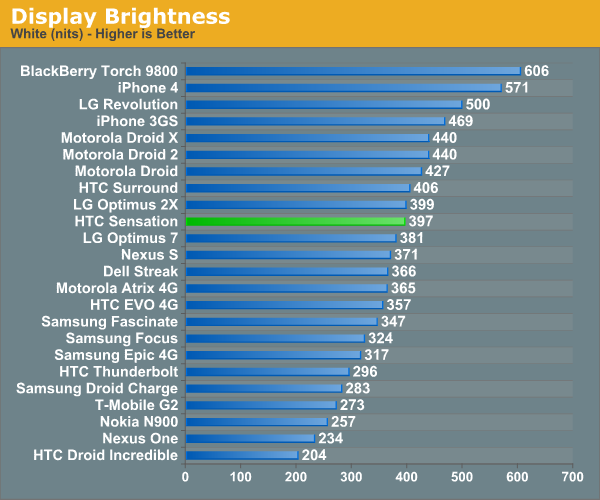
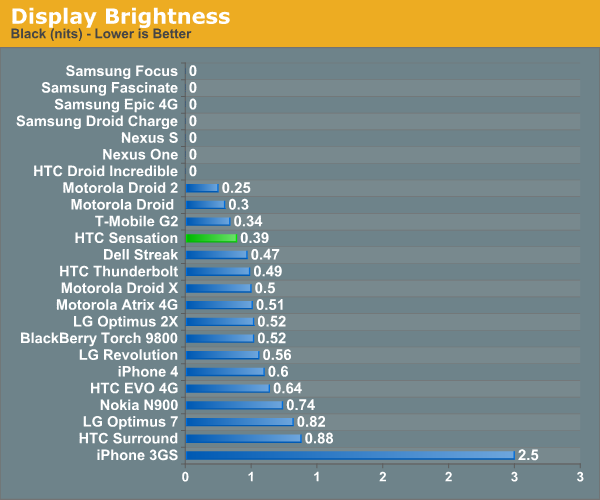
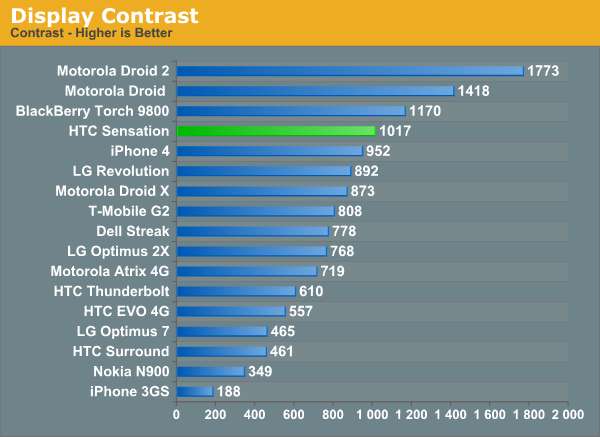
Here the Sensation is actually almost top of the charts when it comes to contrast and its blacks. It isn’t the brightest display at just short of 400 nits, but does very well in the tests. I suspect the Sensation could benefit from more brightness in general, but it isn’t a huge thing.
The previous charts are at maximum brightness, I also want to continue looking at how whites, blacks, and white point change across the brightness scale. To do this, we measure all three at steps of 25% on the brightness slider and create some graphs.
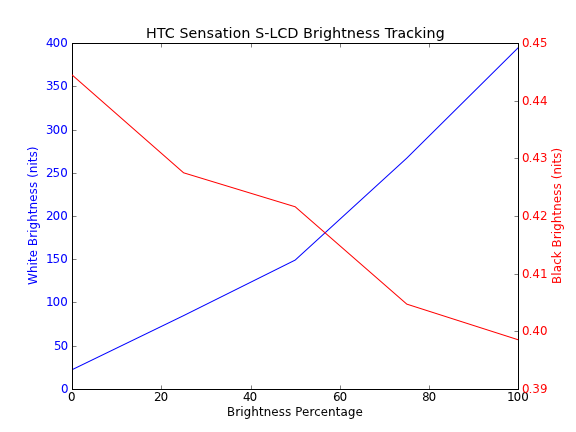

We’ve just started doing this, beginning with the Droid Charge, so we’re also learning here, but the HTC Sensation has some interesting behavior. Blacks strangely enough get better at maximum brightness by a small margin, and again we see that brightness for white is pretty close to linear. Where I’m very impressed with the Sensation is its white point, which is nearly 6500K at maximum brightness. Contrast that to Super AMOLED Plus, which we showed was up past 8000K (blue).
I’d say that mirrors my experience and what I see, especially because I end up pulling down tons of screenshots over ddms on my own calibrated display, and can simply compare side-by-side to the handset. When it comes to faithful color rendering, S-LCD is a clear winner.
Side by side with another Super AMOLED Plus packing smartphone, the AT&T Infuse 4G (which we’re still working on), this is readily apparent. This is essentially a 0.2” bigger but completely comparable version of the Charge / Galaxy S 2 display. Here you can see that the Super AMOLED Plus panel looks bluer, and by comparison the Sensation a bit warmer. In addition, colors are more saturated on the Infuse.


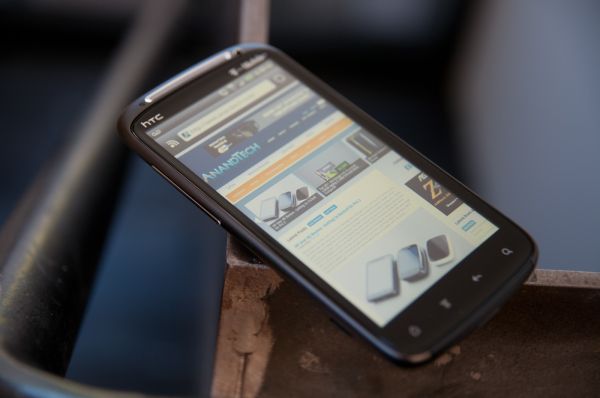
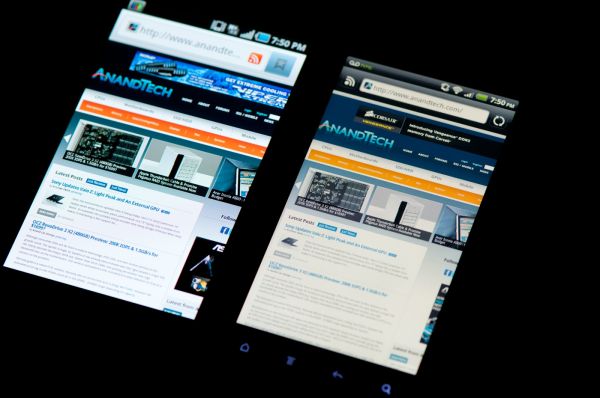
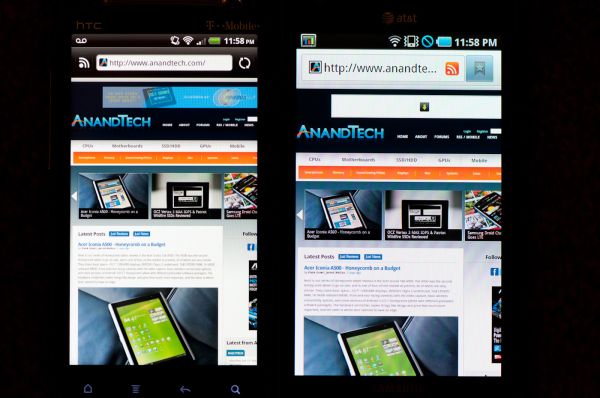








107 Comments
View All Comments
Brian Klug - Friday, July 1, 2011 - link
We're still waiting for an SGS2, hopefully we will get one soon from Samsung USA and be able to compare it in its final form.Take care,
Brian
sam46 - Friday, July 1, 2011 - link
brian,this is one of the few reviews which have praised sensation.but in my view your review is the best.
i am saying this because i believe that unlike other reviewers you not only test mobile phones in your lab but also use them as in daytoday life as a normal user.this gives a better impression of the devices which you review.
many reviewers have given more praises to sgs2 than sensation.they have based their views with the limited time which they had with the devices that too in their testing labs.but i believe that in real world usage sensation makes more sense than sgs2.and this has happened before with their older brothers that is desire and sgs.the reviewers had given more praises to the sgs but the actual users prefered desire over sgs.
though samsung devices looks great on paper,users get frustated with their handsets.
apart from htc in my view hp makes better handsets.lately they are catching up with the hardware but their design sucks.for example take pre3,may be its design makes more sense while handling and using it,but its looks are not good enough to make a good impression.now that they are putting single core1.4ghz processor in pre3,but still they are behind the competition of dualcores.but i do believe that pre3 will give a tough competition to all the dual core phones in terms of speed and performance because of a very light os that is the webos. webos is unarguably the best os out there which is slick and fast,easy to use interface,better management of memory,provides true multitasking,provides a great
feature like just type, and a best notification system.webos is very very light when compare to ios and android,so i think it doesnt need a dual core processor and 1gb of ram.it can perform better than ios and android even with a single core processor and 512mb ram.but hp needs to work on better designs to give a better impression of their devices.
by the way,congratulations brian for this great article.pls tell me what do you think of the observations i made above.
StormyParis - Friday, July 1, 2011 - link
You need to be specific: what hidden drawbacks do Samsung's phones have ? and what hidden qualities, HTC's ?Disclaimer: my current HTC HD2 is the first phone I'm happy with in ages. I had junk from Motorola, LG, and Nokia before that had serious design flaws, plenty of bugs, bad support... or rather, all of the above. My HTC just worked from day one, now it's started a second life under CM7, and I'm very happy with it 2 yrs on.
I was looking foward to buying a Sensation. But the lighter weight, on the whole, better screen, and better moddability f the GS2 are on the verge of convincing me to buy that, instead.
sam46 - Friday, July 1, 2011 - link
Read the review of droid charge by brian klug.He clearly mentioned that samoled+ has some serious problems such as overheating,yellowish tint and oversaturated colours.It is the slimmest smartphone in the world,but according to many users sensation is better to handle.Due to its wait and built quality it feels solid in the hand.And also remember that sgs2 is made of plastic.To know what drawbacks samsung phones have you need to do some googling.Just search for
defects of sgs and sgs2.
bigboxes - Friday, July 1, 2011 - link
Please capitalize your sentences. It was quite the chore trying to read your post. If you want to be taken seriously you need to remember to correctly use those writing rules you learned in school.sam46 - Friday, July 1, 2011 - link
sorry,i am from a non english speaking country.despite that i can write pretty good english,isn't it?SimKill - Monday, July 4, 2011 - link
Do you still not capitalize stuff in your language? I'm a non-native English speaker too, and my language doesn't even have capital and small letters. I still make an effort to write well so that I can convey my message as clearly as possible.sam46 - Monday, July 4, 2011 - link
I will :)Speed3mon - Sunday, July 3, 2011 - link
bigboxes... gAyVisual - Friday, July 1, 2011 - link
Wait, what? Having white appear as red is accurate color now?BTW the Galaxy S II gives users a few choices of color calibration even with stock FW. And just wait and see what the hacked ones do...